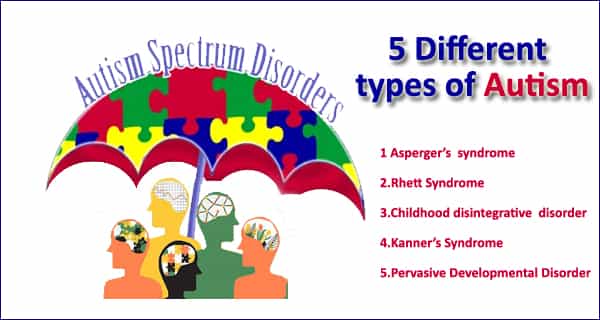Different Types of Autism: Autism is a neurodevelopmental broad range disorder that causes challenges with social skills, repetitive behaviors, difficulty in speech and nonverbal communication, unable to contact the eye, constant moving, and hyper behavior, fixation on certain objects, extreme sensitivity to touch, light, and sound. stress and mental health
What is autism
Autism is a neurodevelopment disorder that causes impairment in social communication and repetitive behavior.
Autism is of many types such as
1. Asperger’s syndrome
2. Rhett Syndrome
3. Childhood disintegrative disorder
4. Kanner’s Syndrome
5. Pervasive Developmental Disorder- not otherwise specified
1. Asperger’s syndrome
Different Types of Autism, Asperger’s syndrome is also known as level 1 autism spectrum disorder. Asperger’s syndrome Children are above average intelligence and have strong verbal skills but feel challenges with social communications. This type of child bears the below-mentioned symptoms,
- Thoughts and behavior are non-flexible.
- Difficulties in switching between activities.
- Feel difficulty to execute functions.
- Unable to express feeling in speech.
- Feels difficult to interact with peers at school or at home.
2. Rhett Syndrome
Different Types of Autism, Rhett Syndrome is rare that is found in infancy. This disorder mainly affects girls, though it is also found in boys. The challenges of Rhett syndrome affect all the aspects of a child’s life. But the child can still enjoy and live a fulfilling life with the proper care.
Common symptoms of Rhett Syndrome are,
- loss of standard movement and coordination.
- feels difficulty communicating and speech.
- feels breathing difficulty.
3. Childhood disintegrative disorder
Childhood disintegrative disorder is a neurodevelopment disorder delayed onset of developmental problems in language, motor skill, or social function. Children experience normal development during the age of 3 to 10 years. The developmental loss is very heartbreaking for their parents. The cause of CDD is unknown but it is linked with the neurobiology of the brain. It is more common in boys than girls.
In CDD child will have normal development till the disorder starts. But as soon as the CDD starts, the child’s development is disturbed. The child may lose any of the following abilities,
- Toileting skill, if the same has already been established.
- acquired language and vocabularies.
- social skill and behavior.
- some motor skills.
4. Kanner’s Syndrome
Its other name is Classic Autistic Disorder. Its symptoms are challenged communicating and understanding others, engaging in virtually no eye contact. Hypersensitivity to smell, light, noise, taste, or touch. Children who are suffering from this disorder show no interest in the world around them.
5. Pervasive Developmental Disorder- not otherwise specified
This order is mild. This type of child feels delayed in benchmarks. Children suffering from this disorder can manage the symptoms of the milder form more easily than those who have been diagnosed with the more severe form of autism.
Treatment
Level 1 autism disorder can be treated with social skill classes, behavior modification classes. A further altered diet free of preservatives and food coloring can be beneficial. Similarly, in all cases, medication under the supervision of a medical specialist in the respective field and psychotherapy under the supervision of a specialist in the field can help the patient to recover from the illness gradually.
Frequently Asked Question About different types of autism
Q. How does autism affect the body?
Ans. The health complications caused by autism are immune disorder or allergy or asthma, metabolic disorders such as diabetes, heart disease, cerebral palsy.
Q. What can mimic high functioning autism?
Ans. The mimic of high functioning disorders are.
Obsessive-compulsive disorder, reactive attachment disorder, social communication disorder, schizophrenia, etc.
Q. At what age is autism usually noticed?
Ans. Autism is usually noticed during the first 12 months of age to 2 years when they stop gaining new skills.
